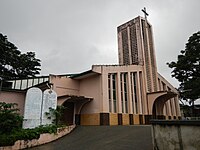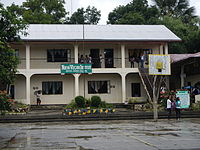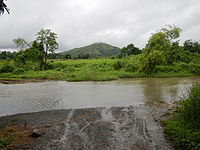Aritao
Aritao | |
|---|---|
| Municipality of Aritao | |
 Downtown area | |
 Seal | |
 Map of Nueva Vizcaya with Aritao highlighted | |
 Aritao Location within the Philippines | |
| Coordinates: 16°17′50″N 121°02′02″E / 16.297258°N 121.033819°ECoordinates: 16°17′50″N 121°02′02″E / 16.297258°N 121.033819°E | |
| Country | Philippines |
| Region | Cagayan Valley |
| Province | Nueva Vizcaya |
| District | Lone district |
| Barangays | 22 (see Barangays) |
| Government | |
| • Type | Sangguniang Bayan |
| • Mayor | Remelina M. Peros |
| • Vice Mayor | Ruben M. Sayo |
| • Representative | Luisa L. Cuaresma |
| • Electorate | 23,405 voters (2019) |
| Area | |
| • Total | 265.60 km2 (102.55 sq mi) |
| Elevation | 476 m (1,562 ft) |
| Highest elevation | 846 m (2,776 ft) |
| Lowest elevation | 346 m (1,135 ft) |
| Population (2020 census) [3] | |
| • Total | 42,197 |
| • Density | 160/km2 (410/sq mi) |
| • Households | 8,501 |
| Economy | |
| • Income class | 2nd municipal income class |
| • Poverty incidence | 16.51% (2015)[4] |
| • Revenue | ₱198,301,761.54 (2020) |
| • Assets | ₱380,500,558.97 (2020) |
| • Expenditure | ₱156,043,151.54 (2020) |
| • Liabilities | ₱53,838,428.45 (2020) |
| Service provider | |
| • Electricity | Nueva Vizcaya Electric Cooperative (NUVELCO) |
| Time zone | UTC+8 (PST) |
| ZIP code | 3704 |
| PSGC | |
| IDD : area code | +63 (0)78 |
| Native languages | Gaddang Ilocano Isinai Kallahan Tagalog |
| Website | aritao |
Aritao, officially the Municipality of Aritao (Gaddang: Ili na Aritao; Ilocano: Ili ti Aritao; Tagalog: Bayan ng Aritao), is a 2nd class municipality in the province of Nueva Vizcaya, Philippines. According to the 2020 census, it has a population of 42,197 people. [3]
The ethnic minority called Isinai (the same term for the local spoken dialect) were the original residents of this town.
Etymology[]
The name Aritao came from the Isinai phrase Ari Tau "which stands for "Our King" (ari=king and tau=our) which refers to the legendary Isinai Chieftain Mengal, a fierce and brave king who resisted Spanish conquest of the Isinai territories around Ajanas and Ynordenan (the areas comprising what is now most of Aritao).
History[]
The town of Aritao was previously called “Ajanas”. This name was later changed to Aritao, after an Isinay word “Ari-Tau”. In January 1767, the intrepid Fr. Manuel Corripio, a Spanish Missionary succeeded in persuading an Igorot King called Ari Mengal and his tribe to live in the lowland, which is the seat of the Municipality of Aritao. These people were later converted into Christianity by Fr. Tomas Gutierrez. In the year 1777, there was a merging of Aritao with the adjacent places into one pueblo under the name of Aritao, which was approved by the Manila Authorities. On 30 June 1917, through the initiative of Councilor Jose Aleman, the application for township of Aritao to higher authorities was finally approved by the Secretary of the Interior.
In 1942, Japanese troops entered Aritao, Nueva Vizcaya. A monument to the gallantry of the Japanese and Filipino soldiers during World War II, located at Barangay Kirang, municipality of Aritao, Nueva Vizcaya. Built in 1978 by the Rakunsankai Society of Japan, it was recently rebuilt using a black glazed stone, and a memorial was engraved in the tablet in Japanese and English. Also offers a scenic view of reforested mountains and hills.
Barangays[]
Aritao is politically subdivided into 22 barangays.
- Banganan
- Beti
- Bone North
- Bone South
- Calitlitan
- Comon
- Cutar
- Darapidap
- Kirang
- Nagcuartelan
- Poblacion
- Santa Clara
- Tabueng
- Tucanon
- Anayo
- Baan
- Balite
- Canabuan
- Canarem
- Latar-Nocnoc-San Francisco
- Ocao-Capiniaan
- Yaway
Climate[]
| Climate data for Aritao, Nueva Vizcaya | |||||||||||||
|---|---|---|---|---|---|---|---|---|---|---|---|---|---|
| Month | Jan | Feb | Mar | Apr | May | Jun | Jul | Aug | Sep | Oct | Nov | Dec | Year |
| Average high °C (°F) | 26 (79) |
28 (82) |
29 (84) |
31 (88) |
30 (86) |
29 (84) |
28 (82) |
28 (82) |
28 (82) |
28 (82) |
28 (82) |
27 (81) |
28 (83) |
| Average low °C (°F) | 18 (64) |
18 (64) |
19 (66) |
22 (72) |
23 (73) |
23 (73) |
23 (73) |
23 (73) |
23 (73) |
21 (70) |
20 (68) |
18 (64) |
21 (69) |
| Average precipitation mm (inches) | 21 (0.8) |
28 (1.1) |
34 (1.3) |
58 (2.3) |
160 (6.3) |
179 (7.0) |
226 (8.9) |
225 (8.9) |
215 (8.5) |
168 (6.6) |
59 (2.3) |
32 (1.3) |
1,405 (55.3) |
| Average rainy days | 7.5 | 8.5 | 10.9 | 14.9 | 23.9 | 25.7 | 26.7 | 25.3 | 24.9 | 18.6 | 11.8 | 8.9 | 207.6 |
| Source: Meteoblue [5] | |||||||||||||
Demographics[]
|
| |||||||||||||||||||||||||||||||||||||||||||||||||||
| Source: Philippine Statistics Authority [6] [7] [8][9] | ||||||||||||||||||||||||||||||||||||||||||||||||||||
Economy[]
| Poverty Incidence of Aritao | |
| Source: Philippine Statistics Authority[10][11][12][13][14][15] | |
Schools[]
- Aritao National High School
- Immaculate Conception Academy
- Saint Teresita's Academy
- Nueva Vizcaya Institute
- Santa Clara High School
Aritao also has a lot of schools for primary (elementary education).
Gallery[]
Nueva Vizcaya Institute
Twin (Skull and Salakot) mountains (visible from Aritao Townhall)
References[]
- ^ Municipality of Aritao | (DILG)
- ^ "2015 Census of Population, Report No. 3 – Population, Land Area, and Population Density" (PDF). Philippine Statistics Authority. Quezon City, Philippines. August 2016. ISSN 0117-1453. Archived (PDF) from the original on May 25, 2021. Retrieved July 16, 2021.
- ^ a b Census of Population (2020). "Region II (Cagayan Valley)". Total Population by Province, City, Municipality and Barangay. PSA. Retrieved 8 July 2021.
- ^ https://psa.gov.ph/sites/default/files/City%20and%20Municipal-level%20Small%20Area%20Poverty%20Estimates_%202009%2C%202012%20and%202015_0.xlsx; publication date: 10 July 2019; publisher: Philippine Statistics Authority.
- ^ "Aritao: Average Temperatures and Rainfall". Meteoblue. Retrieved 4 July 2021.
- ^ Census of Population (2015). "Region II (Cagayan Valley)". Total Population by Province, City, Municipality and Barangay. PSA. Retrieved 20 June 2016.
- ^ Census of Population and Housing (2010). "Region II (Cagayan Valley)". Total Population by Province, City, Municipality and Barangay. NSO. Retrieved 29 June 2016.
- ^ Censuses of Population (1903–2007). "Region II (Cagayan Valley)". Table 1. Population Enumerated in Various Censuses by Province/Highly Urbanized City: 1903 to 2007. NSO.
- ^ "Province of Nueva Vizcaya". Municipality Population Data. Local Water Utilities Administration Research Division. Retrieved 17 December 2016.
- ^ "Poverty incidence (PI):". Philippine Statistics Authority. Retrieved 28 December 2020.
- ^ https://psa.gov.ph/sites/default/files/NSCB_LocalPovertyPhilippines_0.pdf; publication date: 29 November 2005; publisher: Philippine Statistics Authority.
- ^ https://psa.gov.ph/sites/default/files/2003%20SAE%20of%20poverty%20%28Full%20Report%29_1.pdf; publication date: 23 March 2009; publisher: Philippine Statistics Authority.
- ^ https://psa.gov.ph/sites/default/files/2006%20and%202009%20City%20and%20Municipal%20Level%20Poverty%20Estimates_0_1.pdf; publication date: 3 August 2012; publisher: Philippine Statistics Authority.
- ^ https://psa.gov.ph/sites/default/files/2012%20Municipal%20and%20City%20Level%20Poverty%20Estima7tes%20Publication%20%281%29.pdf; publication date: 31 May 2016; publisher: Philippine Statistics Authority.
- ^ https://psa.gov.ph/sites/default/files/City%20and%20Municipal-level%20Small%20Area%20Poverty%20Estimates_%202009%2C%202012%20and%202015_0.xlsx; publication date: 10 July 2019; publisher: Philippine Statistics Authority.
External links[]
| Wikimedia Commons has media related to Aritao. |
- Municipalities of Nueva Vizcaya





